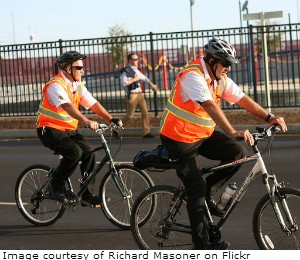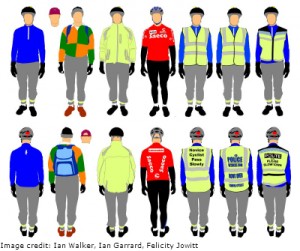Bike Visibility Does Little to Change Drivers’ Dangerous Overtaking
A recent bill in the state of Wyoming would require all bicyclists to wear no less than 200 square inches “of high-visibility fluorescent orange, green or pink color clothing visible from the front and rear of the bicycle.”
 Though lawmakers in favor the bill argued that the new wardrobe requirements were for bicyclists’ own safety, research on driver behavior doesn’t necessarily back this up. In fact, new research is showing that “high-vis” clothing is not as effective at increasing bicycle safety as is often assumed.
Though lawmakers in favor the bill argued that the new wardrobe requirements were for bicyclists’ own safety, research on driver behavior doesn’t necessarily back this up. In fact, new research is showing that “high-vis” clothing is not as effective at increasing bicycle safety as is often assumed.
A study by University of Bath psychological scientist Ian Walker finds that high-visibility clothing is unlikely to prevent the most dangerous passing behavior from drivers. Around 1–2% of overtakes were within 50 cm (about 18 inches) of the rider regardless of what he wore, implying a small proportion of motorists’ passes will always be dangerously close regardless of what a bicyclist wears.
“Many people have theories to say that cyclists can make themselves safer if they wear this or that. Our study suggests that, no matter what you wear, it will do nothing to prevent a small minority of people from getting dangerously close when they overtake you,” says Walker.
A past study from Walker demonstrated that drivers actually encroached much closer to cyclists wearing helmets than those without one. Drivers perceived helmeted riders as more experienced, and thus assumed they could get closer to them as they passed. The research team wanted to investigate whether a bicyclist’s outfit would influence perceptions of experience, and hence, how close drivers got while passing.
A member of the research team, Ian Garrard from Brunel University, used an ultrasonic distance sensor to record how close each vehicle passed during his daily bike commute between Berkshire and outer London (about 50 km round trip). Over several months, data were collected from 5,690 passing vehicles.
Seven outfits were tested, ranging from a specialized racing cyclist outfit—implying high experience and skill—to a vest with “novice cyclist” printed on the back, clearly communicating low
experience.
Some outfits included a high-visibility bicycling jacket or high-visibility safety vests. One vest prominently displayed the word ‘police’ along with a warning that the rider was video-recording their journey. For comparison, another high-visibility vest was modeled after a police officer’s jacket but with one change—it read “polite” instead of “police.”
An online study verified that people were actually picking up on the intended cues for experience. The seven outfits were rated by 269 participants based on how experienced, skilled, and likely to
wobble riders in each outfit appeared.
Overall, the researchers found that variations in the outfits had virtually no effect on how close motorists got as they passed the cyclist. But there was a key exception: Drivers kept a significantly wider—and thus safer—distance from the bicyclist when he was wearing the “police” vest.
 “It is striking that driver behavior to POLICE was so different to POLITE given the key word differed by just one letter,” the researchers write. “Not only was passing much closer on average with POLITE, but subjectively the experimenter reported feeling much more at risk, and encountered overt acts of aggression from several drivers, when wearing POLITE.”
“It is striking that driver behavior to POLICE was so different to POLITE given the key word differed by just one letter,” the researchers write. “Not only was passing much closer on average with POLITE, but subjectively the experimenter reported feeling much more at risk, and encountered overt acts of aggression from several drivers, when wearing POLITE.”
This finding is useful because it confirms that the methodology was sensitive enough to detect different responses to the outfits. Although the study gathered data based on genuine driver behavior on real roads, it’s important to note that there were also variables that they could not standardize.
Recent studies from New Zealand, and Canada have also concluded that the effectiveness of high-visibility gear may be overstated. However, you may not want to toss out your reflective safety vest quite yet. A 2009 review analysis of 42 studies by the Cochrane Collaboration concluded that fluorescent materials can improve safety for cyclists and pedestrians. Although these visibility measures may help drivers notice pedestrians and cyclists, more research is needed to determine whether increased visibility actually translates to fewer crashes, injuries, and deaths.
“We suggest, based on the data presented here, that it is unlikely bicyclist outfits could ever provide a sustainable solution to rider safety,” Walker and colleagues conclude. “We suggest that the optimum solution to the very closest overtakes will not lie with bicyclists themselves, and instead we should look to changes in infrastructure, education or the law to prevent drivers getting dangerously close when overtaking bicyclists.”
Reference
Walker, I., Garrard, I., & Jowitt, F. (2014). The influence of a bicycle commuter’s appearance on drivers’ overtaking proximities: an on-road test of bicyclist stereotypes, high-visibility clothing and safety aids in the United Kingdom. Accident Analysis & Prevention, 64, 69-77. doi:10.1016/j.aap.2013.11.007





Comments
The purpose of high-visibility gear is to help inattentive drivers or drivers with poor vision to recognize and avoid the rider, especially in low visibility conditions such as rain or darkness. If the driver would have seen the cyclist regardless, there’s no reason to think that the gear would somehow magically make the driver into a more considerate person. Does anyone believe that high-visibility gear is intended to stop aggressive drivers from being aggressive? It makes sense that impersonating a police officer would change a person’s driving behaviour, as would recording license plates and passing distances to cite drivers who get illegally close, but that’s not the problem that hi-vis is intended to solve. Downplaying the value of high visibility gear by measuring its efficacy for an unintended purpose is foolish and irresponsible of the authors.
Could not agree more with concerned. I’ve seen stats that say a lot of accidents are down to not seeing the person.
This was just recording how close they pass once they have seen the person. A different matter.
So we can dress as brightly/safely as we want, but still risk our lives due to the ignorance of some drivers. Not great!
The comment by CONCERNED mistakes the purpose og high visibility gear. The purpose of wearing such is to improve the safety of the wearer. The >assumption< is that safety is compromised by some difficulty in seeing the (cyclist in this case) when not wearing the gear. That increasing the visibility of the 'cyclist DID NOT decrease the incidence of dangerously close passes demonstrates that the assumption is likely untrue.
As for "nattentive drivers or drivers with poor vision" they should be taken off the road by enforcing existing legislation, making the roads much safer for all users. All drivers of course, "especially in low visibility conditions such as rain or darkness" should be driving no faster than a speed at which they can stop in the distance they can see to be clear. Again, education and enforcement is more likely to improve road safety than hi-vis gear which clearly makes no difference to the safety of the wearer.
APS regularly opens certain online articles for discussion on our website. Effective February 2021, you must be a logged-in APS member to post comments. By posting a comment, you agree to our Community Guidelines and the display of your profile information, including your name and affiliation. Any opinions, findings, conclusions, or recommendations present in article comments are those of the writers and do not necessarily reflect the views of APS or the article’s author. For more information, please see our Community Guidelines.
Please login with your APS account to comment.